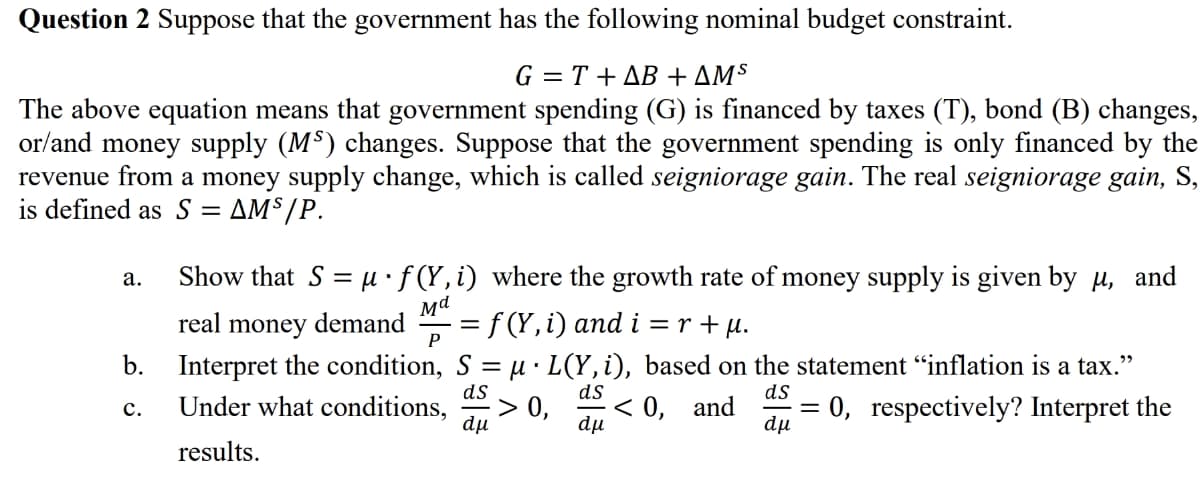Question 2 Suppose that the government has the following nominal budget constraint. G = T+AB+ AMS The above equation means that government spending (G) is financed by taxes (T), bond (B) changes or/and money supply (M$) changes. Suppose that the government spending is only financed by th revenue from a money supply change, which is called seigniorage gain. The real seigniorage gain, S is defined as S = AMS/P. a. Show that S = μ·f (Y, i) where the growth rate of money supply is given by µ, and Md real money demand = f(Y, i) and i=r+µ. P b. Interpret the condition, S = µ · L(Y, i), based on the statement "inflation is a tax.” = 0, respectively? Interpret the ds C. Under what conditions, ds > 0, ἀμ ds < 0, and ἀμ dμ results.
Question 2 Suppose that the government has the following nominal budget constraint. G = T+AB+ AMS The above equation means that government spending (G) is financed by taxes (T), bond (B) changes or/and money supply (M$) changes. Suppose that the government spending is only financed by th revenue from a money supply change, which is called seigniorage gain. The real seigniorage gain, S is defined as S = AMS/P. a. Show that S = μ·f (Y, i) where the growth rate of money supply is given by µ, and Md real money demand = f(Y, i) and i=r+µ. P b. Interpret the condition, S = µ · L(Y, i), based on the statement "inflation is a tax.” = 0, respectively? Interpret the ds C. Under what conditions, ds > 0, ἀμ ds < 0, and ἀμ dμ results.
Chapter9: Demand-side Equilibrium: Unemployment Or Inflation?
Section9.A: The Simple Algebra Of Income Determination And The Multiplier
Problem 4TY
Related questions
Question

Transcribed Image Text:Question 2 Suppose that the government has the following nominal budget constraint.
G = T+AB + AMS
The above equation means that government spending (G) is financed by taxes (T), bond (B) changes,
or/and money supply (MS) changes. Suppose that the government spending is only financed by the
revenue from a money supply change, which is called seigniorage gain. The real seigniorage gain, S,
is defined as S : AMS/P.
Show that S = μ·f (Y, i) where the growth rate of money supply is given by µ, and
Md
real money demand = f(Y, i) and i=r+μ.
P
=
b. Interpret the condition, S
Under what conditions,
ds
C.
dμ
results.
a.
µ· L(Y, i), based on the statement "inflation is a tax."
ds
ds
< 0, and = 0, respectively? Interpret the
dμ
dμ
> 0,
Expert Solution
This question has been solved!
Explore an expertly crafted, step-by-step solution for a thorough understanding of key concepts.
Step by step
Solved in 5 steps

Knowledge Booster
Learn more about
Need a deep-dive on the concept behind this application? Look no further. Learn more about this topic, economics and related others by exploring similar questions and additional content below.Recommended textbooks for you


Brief Principles of Macroeconomics (MindTap Cours…
Economics
ISBN:
9781337091985
Author:
N. Gregory Mankiw
Publisher:
Cengage Learning


Brief Principles of Macroeconomics (MindTap Cours…
Economics
ISBN:
9781337091985
Author:
N. Gregory Mankiw
Publisher:
Cengage Learning